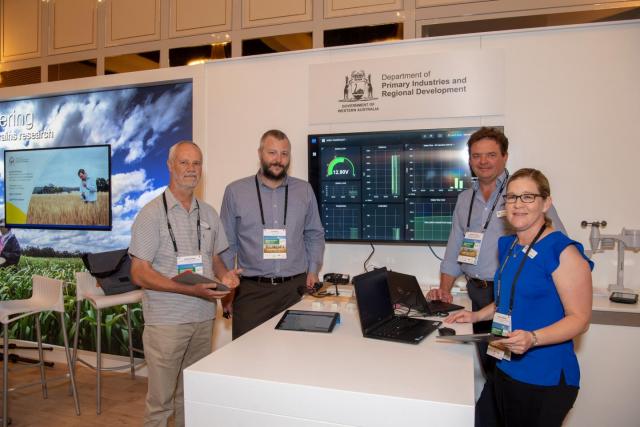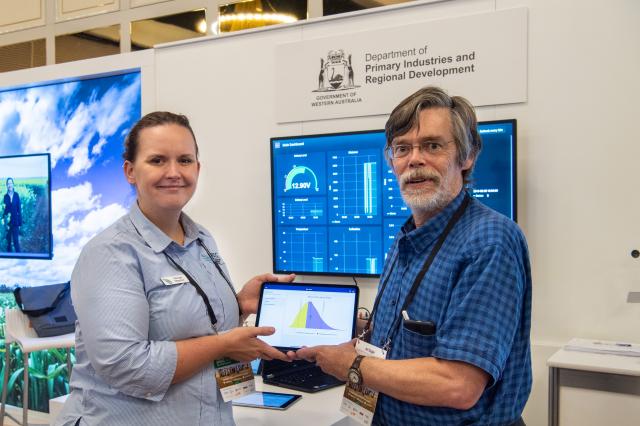Dont let diseases reduce your crop potential
You can employ some proactive management strategies to minimise potential disease impacts on your crops this season. Weeds and/or volunteer crop plants present at the start of the new cropping season, particularly in or adjacent to cropping paddocks, pose a greater risk of spread of pests and diseases to newly emerging crops.
Biotrophic diseases are carried over on green bridge (volunteer plants, weeds). Biotrophic diseases include rusts on wheat and barley, and mildew on wheat, barley, oats and canola. Root (take-all, rhizoctonia, common root rot) and crown (crown rot) diseases (https://www.agric.wa.gov.au/barley/root-disease-under-intensive-cereal-p...) and nematodes (cereal cyst nematode, root lesion nematode) (https://www.agric.wa.gov.au/barley/root-lesion-and-burrowing-nematodes-d...) can also be supported by a green bridge. Management strategies – Remove the green bridge by using herbicides and grazing at least four weeks prior to seeding, use of registered fungicides at seeding (seed dressing or in-furrow) in areas at risk of early disease.
Necrotrophic diseases are carried over on stubble and include powdery mildew, wheat yellow spot and Parastagonospora (septoria) nodorum, barley scald and net blotches, canola blackleg and white leaf spot, field pea black spot, chickpea ascochyta, cereal crown rot and take-all. Management strategies - Crop rotation with good grass weed control, avoid sowing alongside or downwind of infected stubble, and use of registered fungicides at seeding (seed dressing or in-furrow).
Diseases carried by vectors such as aphids or mites that survive summer on green bridge include barley yellow dwarf virus, wheat streak mosaic virus, and beet western yellow virus. Management strategy – Remove the green bridge.
Seed borne examples include anthracnose in lupins, ascochyta in chickpea, barley scald, cereal smuts and bunts, net-type net blotch, which is not considered a big risk when compared to infection from wind borne spores, and wheat streak mosaic virus. Management strategies – Seed testing, new clean seed, use of registered fungicides at seeding (seed dressing or in-furrow).
Soil borne – examples include lupin brown spot, common bunt of wheat, flag smut of wheat, covered smut of barley, loose and covered smut of oats, root diseases (common root rot, rhizoctonia, Pythium root rot, take-all) and nematodes (cereal cyst nematode, and root lesion nematode). Management strategies – Soil testing, particularly if you observed uneven growth or bare patches in crops last year,
crop rotation with good weed grass control, fallow, and use of registered fungicides at seeding (seed dressing or in-furrow).
Where sclerotinia stem rot has previously occurred, sclerotinia fruiting bodies called sclerotes can survive in stubble and soil for up to six years, infecting canola, lupins, chickpeas and lentils, so non-host species, such as cereals, should be grown for at least three years in paddocks that were recently affected.
Some other key tips:
- Plan variety choices and crop rotations to minimise disease risks. Be aware of the risk factors associated with each crop disease and variety - give preference to varieties with some disease resistance. Crop rotation is particularly important for reducing the risk of stubble borne and soil borne diseases. Find out more crop specific disease management and the disease ratings of different varieties on the DPIRD website
- Monitor and report to PestFax the presence of disease on volunteer cereals or early sown crops.
- Consider the use of registered seed or in-furrow fungicide treatments (https://www.agric.wa.gov.au/barley/seed-dressing-and-furrow-fungicides-c...) for seed-borne or other diseases your crop could be at risk of (including foliar and root diseases) to avoid the need for early fungicide sprays, should disease strike early. Information on registered seed dressing and in-furrow fungicides for cereals is available on the crop disease webpage.
- Be aware of foliar fungicide product registrations, limits on number of times a particular mode of action can be used on a crop per season, optimal timing and rates of sprays for effective control, and withholding periods for grazing and harvesting. Foliar fungicide registration charts for cereals, canola and lupin are available on the crop disease webpage and spray strategies are outlined on specific crop disease management pages.
- Check out the PestFax map, which shows the diseases that were reported from your area last season and will give you an idea of the diseases you might be at a higher risk of this season. Be sure to subscribe to the PestFax newsletter if you haven’t already, to receive information on pest and disease reports across the WA Wheatbelt next season.
- Download canola disease apps to assist with in-season management. BlacklegCM and SclerotiniaCM are free apps available for tablets from the App store or Google play. They provide guidance for economic application of fungicide for managing blackleg and sclerotinia respectively.
See also
green bridge pest and disease management
registered foliar fungicides for cereals
Latest research showcased at the 2019 Perth GRDC Research Updates

The Department of Primary Industries and Regional Development showcased their latest research at the 2019 GRDC Grains Research Updates in Perth recently.
Research Updates is Western Australia’s premier annual grains industry event, providing agronomists, consultants, researchers and growers with a forum to showcase innovative thinking and the latest research outcomes relevant to the Western Region.
A record crowd of more than 650 attended the annual industry event at Crown Towers, with 31 DPIRD staff presenting at the research sessions.
The two-day event provided up-to-date information on high priority issues, ranging from technical research results that could be applied on-farm through to broader industry perspectives.
General sessions covered issues impacting grower profitability, including nutrition management, frost and soil constraints.
Extended focus sessions included information on ‘effective messaging’ to speed up the adoption of innovations to improve farm profitability; new research in the understanding and management of fungal diseases; and best management and control of ‘new’ weeds.
Director General Ralph Addis said the success of the event highlighted the importance industry placed on research.
“Scientific research is key to helping our growers change and adapt to produce better crops, increase productivity and export competitiveness and, in turn, support our regional economies and communities.”
Research papers presented at the 2019 GRDC Grains Research Updates can be found on the Grains Industry of Western Australia (GIWA’s) web page.
SclerotiniaCM app to boost canola disease management

A new app to assist canola growers across Australia to better manage the canola disease, Sclerotinia stem rot, is now available.
The free SclerotiniaCM app was developed by a collaboration led by the Department of Primary Industries and Regional Development with co-investment from the GRDC and can be used by growers and consultants across Australia.
Department principal research officer Art Diggle said the app was designed to assist canola growers to make more informed decisions about fungicide applications to optimise yields and minimise costs.
Dr Diggle said the app was designed for use during the growing season to assist crucial treatment decisions using evidence-based information to estimate the likely returns from spraying for Sclerotinia for individual paddock scenarios.
“The app is simple to use and easy to navigate, requiring the user to input individual paddock data, as well as recent and expected weather conditions,” he said.
“It then uses a widely-accepted forecasting model to generate the predicted return from a fungicide treatment, in dollars per hectare, highlighting the probability of a negative or positive return.
“The user can select from several alternative views of the predicted results to suit themselves, including tables and graphs.”
The SclerotiniaCM app was tested by growers and consultants from across Western Australia’s agricultural region in 2018 and received good reviews and productive feedback.
“Short videos about how to use the app and optimise its use have also been incorporated to assist users to get the most out of it.”
Sclerotinia stem rot is the most unpredictable disease threatening WA canola crops, which, in conducive conditions, can affect up to 20 per cent of crops across the grainbelt.
The app draws on several years of field trials and observations, as well as experimental data and expert knowledge from contributors from throughout the country.
Dr Diggle said the SclerotiniaCM app would give canola growers and consultants more confidence in decisions about whether to invest in spraying for this problematic disease.
“It is intended that the app be continually updated to reflect new experimental results as they become available,” he said.
“This semi-quantitative approach to calibration recognises the fact that Sclerotinia management decisions are highly influenced by seasonal conditions, which vary from year-to-year.”
Other contributors to the app’s development include the CSIRO, New South Wales Department of Primary Industries, the South Australian Research and Development Institute and Marcroft Grains Pathology in Victoria.
The app is a part of the department’s Crop Management series, which also includes the BlacklegCM app to help identify the most profitable management strategy for canola growers.
The SclerotiniaCM app, which is a tablet-based program, and the BlacklegCM app are available for free from the App Store and Google Play. For more details about the apps click here.
